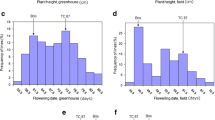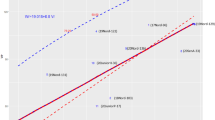Summary
For genetic analysis of head blight in winter rye (Secale cereale) caused by Fusarium culmorum, six homozygous inbred lines from the Petkus gene pool were crossed in all combinations to obtain 15 diallel F1 crosses and the corresponding 15 F2 crosses. These materials and 10 additional inbreds were artificially inoculated in a 2-year field experiment. The inbreds were also tested with F. graminearum in a separate sub-experiment.
Single disease rating, average disease rating, and yield components (grain-weight per spike, 1000-grain weight, kernel number per spike) relative to the non-inoculated treatment were significantly affected by Fusarium head blight in all material groups. The relative grain weight per spike ranged from 26% to 88%. Significant genotypic and genotype x year interaction variances were found throughout. Heritabilities were highest for homogeneous inbreds (h2=0.6–0.8) and lowest for heterogeneous F2 crosses (h2=0.4–0.6). Disease rating and relative grain-weight per spike were highly correlated for the inbreds and F2 crosses (r≈0.7, P≤0.01), but lower for the F1 crosses (r≈0.6, P≤0.05). Inter-annual correlation coefficients for disease ratings and relative grain-weight per spike ranged from r≈0.7 (inbreds) to r≈0.5 (F2 crosses). The diallel analysis showed significant GCA effects only for relative 1000-grain weight in 1990, but significant SCA and SCAx year interaction variances for most traits. The resistances of 16 inbreds to F. culmorum and F. graminearum were tightly associated for all traits (r=0.96–0.97, P≤0.01).
In conclusion, only slow progress can be expected from selecting for Fusarium head blight resistance in rye due to the limited amount of additive genetic variance and the great improtance of environmental factors.
Similar content being viewed by others
References
Chelkowski, J., 1989. Formation of mycotoxins produced by Fusaria in heads of wheat, triticale and rye. In: J. Chelkowski (Ed.), Fusurium—Mycotoxins, Taxonomy and Pathogenicity. Elsevier, Amsterdam. pp. 63–85.
Cochran, W.G. & G.M. Cox, 1957. Experimental designs. 2nd edition, Wiley, New York.
Duben, J. & H. Fehrmann, 1979. Vorkommen und Pathogenität von Fusarium-Arten an Winterweizen in der Bundesrepublik Deutschland. II. Vergleich der Pathogenität als Erreger von Keimlings-, Halmbasis- und Ährenkrankheiten. Z. PflKrankh. PflSchutz 86: 705–728.
Focke, I. & R. Rocke, 1971. Genwirkungen beim Auftreten von Fusarium-Kolbenfäule in frühem Körnermais. Arch. Züchtungsforsch. 1: 195–199.
Geiger, H.H., 1985. Hybrid breeding in rye (Secale cereale L.). Proc. EUCARPIA Meeting of the Cereal Section on Rye. Part I. Svalöv, Sweden. pp. 237–265.
Geiger, H.H., 1990. Wege, Fortschritte und Aussichten der Hybridzüchtung. In: G. Haug, G. Schuhmann, G. Fischbeck (Eds.), Pflanzenproduktion im Wandel. VCH-Verlag, Weinheim. pp. 41–72.
Gendloff, E.H., E.C. Rossman, W.L. Casale, T.G. Isleib & L.P. Hart, 1986. Components of resistance to Fusarium ear rot in field corn. Phytopathology 76: 684–688.
Gerlach, W. & H. Nirenberg, 1982. The genus Fusarium-a pictorial atlas. Mitt. Biol. Bundesanst. Land-und Forstwirt. Berlin-Dahlem, Band 209, 406pp.
Griffing, B., 1956. Concept of general and specific combining ability in relation to diallel crossing systems. Aust. J. Biol. Sci. 9: 463–493.
Hallauer, A.R. & J.B. Miranda, 1981. Quantitative genetics in maize breeding. Iowa State Univ. Press, Ames, 468pp.
Hart, L.P., E.H. Gendloff & E.C. Rossman, 1984. Effect of corn genotypes on ear rot infection by Gibberella zeae. Plant Dis. 68: 296–298.
Höxter, H., G. Sieber, T. Miedaner & H.H. Geiger, 1992. Test systems for evaluating quantitative resistance to Fusarium culmorum and F. graminearum foot rot in rye. J. Plant Breeding 108: 274–282.
Koczowska, I. & E. Jelinska, 1983. Influence of infestation of rye heads by fungi of the genus Fusarium on the grain yield. (Polnish). Biuletyn Inst. Hodowli i Aklimatyzacji Roslin 150: 21–26.
Leiteritz, R. & I. Focke, 1977. Auftreten der Spelzenbräune (Septoria nodorum Berk.) und der partiellen Weißährigkeit (Fusarium culmorum (W.G.Sm.) Sacc.) an Winterweizen in der Deutschen Demokratischen Republik in Abhängigkeit vom Niederschlag. Arch. Phytopathol. Pfl.schutz 13: 407–418.
Ludwig, W.F., 1992. Quantitativ-genetische und methodische Untersuchungen zur Züchtung auf Fußkrankheitsresistenz bei Roggen. Diss. Hohenheim, Stuttgart, Germany, 76 pp.
Manka, M., 1989. Fusaria as pathogens of cereal seedlings. In: J. Chelkowski (Ed.), Fusarium — Mycotoxins, Taxonomy and Pathogenicity. Elsevier, Amsterdam. pp. 329–355.
Mesterhazy, A., 1977. Reaction of winter wheat varieties to four Fusarium species. Phytopath. Z. 90: 104–112.
Mesterhazy, A., 1987. Selection of head blight resistant wheats through improved seedling resistance. Plant Breeding 98: 25–36.
Mesterhazy, A., 1988. Expression of resistance of wheat to Fusarium graminearum and F. culmorum under various experimental conditions. J. Phytopathology 123: 304–310.
Mesterhazy, A., 1989. Progress in breeding of wheat and corn genotypes not susceptible to infection by Fusaria. In: J. Chelkowski (Ed.), Fusarium — Mycotoxins, Taxonomy and Pathogenicity. Elsevier, Amsterdam. pp. 357–386.
Miedaner, T. & H. Walther, 1987. Ermittlung der Fusarium-Resistenz im Ährenstadium von Weizen. Z. PflKrankh. PflSchutz 94: 337–347.
Mielke, H., 1988. Untersuchungen über Fusarium culmorum (W.G.Sm.) Sacc. als Fuß- und Ährenkrankheitserreger beim Weizen. Mitt. Biol. Bundesanst. Land- u. Forstw. Berlin-Dahlem, 238, 101 pp.
Mode, C.F. & H.F. Robinson, 1959. Pleiotropism and the genetic variance and covariance. Biometrics 15: 518–537.
Nirenberg, H., 1976. Untersuchungen über die morphologische und biologische Differenzierung in der Fusarium-Sektion Liseola. Mitt. Biol. Bundesanst. Land- und Forstwirtsch. Berlin, 117 pp.
Schmidt, H.K., 1991. Schätzung quantitativ-genetischer Parameter für partielle Resistenz von Roggen gegenüber Echtem Mehltau unter Feldbedingungen. Diss. Hohenheim, Stuttgart, Germany, 77 pp.
Schneider, R., 1958. Untersuchungen über die Variabilität und Taxonomie von Fusarium avenaceum (Fr.) Sacc. Phytopath. Z. 32: 95–148.
Snijders, C.H.A., 1990a. Fusarium head blight and mycotoxin contamination of wheat, a review. Neth. J. Plant Path. 96: 187–198.
Snijders, C.H.A., 1990b. The inheritance of resistance to head blight caused by Fusarium culmorum in winter wheat. Euphytica 50: 11–18.
Stack, R.W. & M.P. McMullen, 1985. Head blighting potential of Fusarium species associated with spring wheat heads. Can. J. Plant Pathol. 7: 79–82.
Teich, A.H., 1989. Epidemiology of wheat (Triticum aestivum L.) scab caused by Fusarium spp. In: J. Chelkowski (Ed.), Fusarium — Mycotoxins, Taxonomy and Pathogenicity. Elsevier, Amsterdam. pp. 319–328.
Utz, H.F., 1978. PZ 14 — Ein Programm zur Diallelanalyse, Institute for Plant Breeding, Seed Science and Population Genetics, University of Hohenheim, Stuttgart, Germany.
Utz, H.F., 1986. PLABCOV — Ein computerprogramm für Kovarianzanalysen, Institute for Plant Breeding, Seed Science and Population Genetics, University of Hohenheim, Stuttgart, Germany.
Utz, H.F., 1988. PLABSTAT — Ein Computerprogramm zur statistischen Analyse von pflanzenzüchterischen Experimenten, Version 2C. Institute for Plant Breeding, Seed Science and Population Genetics, University of Hohenheim, Stuttgart, Germany.
VanderPlank, J.E., 1963. Plant diseases: Epidemics and control. Academic Press, New York. 349 pp.
Wilde, P., 1987. Schätzung von Populationsparametern und Untersuchungen zur Effizienz verschiedener Verfahren der Rekurrenten Selektion bei Winterroggen. Diss. Hohenheim, Stuttgart, Germany, 118 pp.
Zadoks, J.C., T.T. Chang & C.F. Kunzak, 1974. Decimal code for growth stages of cereals. Weed Research 15: 415–421.
Author information
Authors and Affiliations
Rights and permissions
About this article
Cite this article
Miedaner, T., Borchardt, D.C. & Geiger, H.H. Genetic analysis of inbred lines and their crosses for resistance to head blight (Fusarium culmorum, F. graminearum) in winter rye. Euphytica 65, 123–133 (1992). https://doi.org/10.1007/BF00022574
Received:
Accepted:
Issue Date:
DOI: https://doi.org/10.1007/BF00022574




